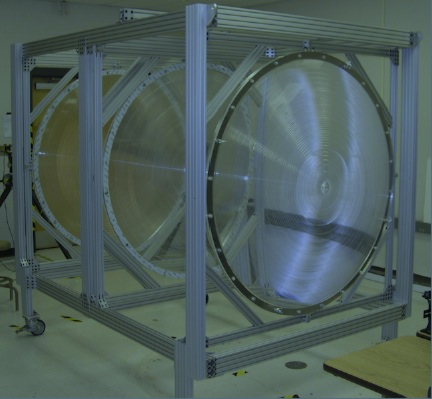Instrument

EUSO-Balloon instrument configured for first flight
Functions and main features
The optical subsystem comprises an optical bench that focuses incoming UV photons onto the finely pixelated focal surface consisting of an array of multi-anode photomultipliers (MAPMTs) sensitive to UV radiation in the 290-430 nm range and offering very good detection performance. The focal surface (FS) is complemented by complex electronics enabling measurements to be acquired within one microsecond or so, including automatic fast-switch protection for the photo-detectors against intense light fluxes. For each event triggered, the front-end electronics records a sequence of 128 consecutives images with a time resolution of one gate time unit (GTU), equal to 2.5 milliseconds.
Optical bench Fresnel lenses
Photo-Detector Module (PDM)
Photo-Detector Module (PDM): the 36 multi-anode photomultiplier tubes (MAPMTs) are covered by UV filters; four MAPMTs form an elementary cell (EC). The PDM comprises nine ECs, six EC boards and one PDM board.
UV photons collected by the telescope are focused onto the PDM comprising 36 multi-anode photomultiplier tubes (MAPMTs) and its front-end electronics, high-voltage power supply and trigger logic. The key features of this UV camera are its spatial resolution of a few millimetres, time resolution of a few nanoseconds, quantum efficiency (QE) of up to 30%—making it possible to detect single photons—and a wide dynamic range of more than six orders of magnitude. As the focal plane of JEM-EUSO will consist of 140 closely packed PDMs, EUSO-Balloon’s PDM has a modular design and is four-side buttable, i.e. its compact array of 66 MAPMTs covers a detection surface of 16.7 x 16.7 cm2, and it is fully contained in a volume of 17 x 1,720 cm3 with its mechanical support and front-end electronics included. The Hamamatsu R11265-103-M64 MAPMTs have 8 x 8 pixels of 2.9 x 2.9 mm2 each and an overall footprint of 26.2 x 26.2 mm2. A UV colour glass filter is bonded to the window of the MAPMT with optical glue. The filter (SCHOTT BG3 with an anti-reflective coating) transmits UV light in a band between 290 and 430 nm. At the rear of the MAPMT array, six EC-ASIC boards perform continuous analogue readout, detecting individual photons in each channel so as to count them per a unit of time called a gate time unit (1 GTU = 2.5 milliseconds) and doing analogue-to-digital conversion.
The High-Voltage Power Supply (HVPS) consists of a miniaturized Cockroft-Walton (CW) generator, a switch system used to reduce the photocathode voltage to lower the MAPMT gain, and the logic system to manage the interfaces with the other elements of the electronic chain.
Behind the EC-ASIC stack, the PDM board handles the interfaces between the various boards in the PDM and the Data Processor (6 EC-ASICs, HVPS in the PDM; the HK and CCB from the DP system). Its core is an industrial Virtex6 XC6VLX240T FPGA. Besides managing the configuration, the PDM board governs the data stream from the 36 ASICs by means of the six EC-ASIC boards. The FPGA has to absorb a data volume of 1 Gbyte per second from the EC-Units, transmitting a part of the data to the Central Cluster Board (CCB) of the DP. The various parameters of the PDM’s performance—photoelectron counting rate, sensitivity and detection, and absolute calibration—are treated in detail by a number of articles.



